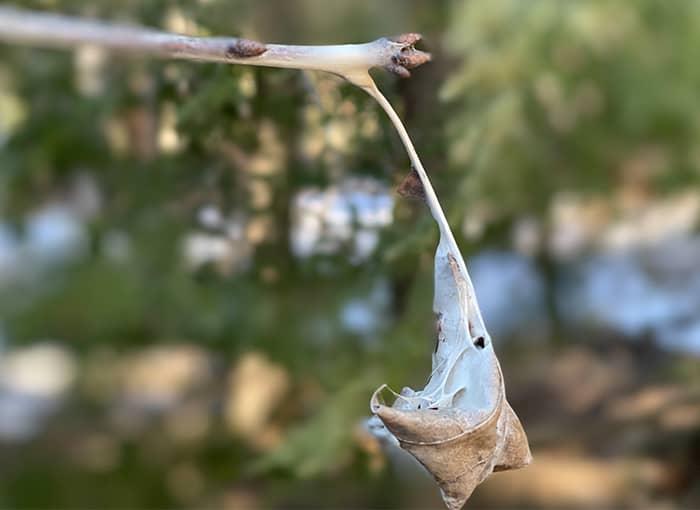February 21, 2025
How to Spot and Identify Browntail Moth Nests: The Homeowner’s Guide to Prevention and Protection
Dealing with pests can feel overwhelming as a homeowner, especially when unsure what to look for. The browntail moth caterpillar is one pest that can cause issues during the warmer months. These larvae can strip leaves from trees and shed toxic hairs, potentially causing serious skin irritations and respiratory problems. The good news is that identifying their nests during the winter months will allow you to take action to protect both your home and your loved ones. Here’s what you need to know.

What are browntail moths?
Browntail moths may look harmless as adults, with their white wings and fuzzy brown bodies, but the caterpillars that appear in the spring can wreak havoc. These larvae feed on leaves, especially those of oak, apple, and other deciduous trees, and create visible nests. Their toxic hairs make them even more concerning, which can cause serious skin rashes and respiratory issues in humans. Understanding how to spot their nests is key to preventing damage and health problems in your home and yard.
Where to find browntail moth nests
Browntail moths are crafty when it comes to building their nests. They prefer high, secluded spots in the branches of certain trees. Oak trees are a favorite, but browntail moths also nest in other deciduous trees.
Since the nests are woven into the tree branches, they’re harder to spot when leaves are present. Winter is the best time to inspect your trees for the distinctive webbing, as it's much more visible when the trees are bare.
How to identify browntail moth nests
Identifying browntail moth nests doesn’t have to be difficult if you know what to look for. Overwintering nests are webs of white silk spun tightly around twigs and tree branches. The silk shines in the sunlight and resembles “stubborn leaves,” or a group of leaves that didn’t fall during autumn. Since these nests can look similar to other non-invasive species, it’s best to have a professional identify any potential nests near your home.
What’s happening inside the nests?
Inside these white nests are caterpillars, or browntail moths in their larvae phase. Each nest can contain anywhere from 25-400 caterpillars! If left undisturbed, these caterpillars will emerge in spring and feed off the tree’s leaves while growing into their adult phase (moths).
Why is identifying browntail moth nests important?
Why is it so important to find these nests early? The simple answer is health and safety. As we discussed above, the toxic hairs that browntail moths shed can cause skin rashes, breathing problems, and even long-term respiratory issues. If you have young children or pets, the risk increases even more. Proactive identification of their nests can help prevent these health issues.
Promptly removing the nests also prevents the moths from reproducing and spreading. An infestation can quickly get out of hand, especially during peak moth season in late spring and summer.
How to remove browntail moth nests
If you’ve identified a browntail moth nest in your trees and want to remove it yourself, it’s crucial to handle the removal with care.
- Wear protective clothing
Always wear gloves, long sleeves, and a mask when handling or removing a nest. The moths’ toxic hairs can be harmful if they come into contact with your skin or lungs. - Use the right tools
To remove nests, use an extendable pole pruner or hand snips to dislodge them carefully. Avoid touching nests directly with your hands. - Dispose of the nest properly
Make sure to dispose of nests in a way that doesn’t contact other areas of your yard or home. Sealing them in a plastic bag and throwing them away in an outdoor trash bin is a good option. You may consider burning overwintering webs after you’ve removed them from trees, but it should be done carefully and with the proper burn permit in hand. Also, if you choose the latter option, take precautions to protect yourself from the toxic hairs still present. - Inspect your property
After removing overwintering nests, inspect your yard for other potential nesting spots. Keep an eye on your trees to catch new nests before they become an issue.
Why it’s best to call a pest control company for help
If you’re uncomfortable handling the removal process yourself or spotted multiple nests, it’s a good idea to call a professional pest control service specializing in browntail moth control. Here at Pine State Pest Solutions, we offer effective browntail moth treatments in Hebron, Norway, Oxford, and other Maine communities. We’re currently inspecting properties for BTM activity and scheduling tree injections and spraying to be completed this spring. When you contact us for help protecting your family and property from these destructive pests, we’ll evaluate the situation, recommend the best treatment option, and provide you with an estimate for service.
Stay protected from browntail moths
Browntail moths and their caterpillars may be small, but they can cause significant problems if left unchecked. By learning to spot their nests early and taking action quickly, you can avoid the health risks and damage they cause. Whether you decide to remove the nests yourself or seek professional help, it’s essential to stay vigilant, especially during the warmer months when these pests are most active.
Pine State Pest Solutions has helped hundreds of homeowners in Maine protect their families and properties from browntail moths, and we’re ready to help you, too! Contact us today for assistance.
This blog was originally published on on March 3, 2021, and has been updated to reflect the most up-to-date information.

 Subscribe
Subscribe